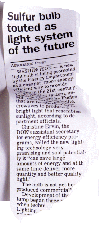

 A man experiencing sudden attacks of dementia is referred to the Crump
Institute for Biological Imaging at UCLA. Positron Emission Tomography or PET
scanning of the patient's brain reveals the characteristic glucose metabolism
that enables doctors to correctly diagnose the cause as Alzheimer's disease. A
few years ago, the patient might have incorrectly been diagnosed as having
suffered a small stroke or been thought the victim of Parkinson's disease.
In California's Silicon Valley, at a computer chip manufacturing center, an
electron beam is used to create an experimental computer chip that can hold a
thousand times more information than what is on the market today. Across the
country at the Fermi National Accelerator Laboratory's Tevatron evidence for
the crucial missing piece in the scientific picture of matter is found.
In homes and offices throughout the country burned-out incandescent light bulbs
are replaced with simple screw-in compact fluorescent bulbs providing identical
illumination at a fraction of the cost.
A man experiencing sudden attacks of dementia is referred to the Crump
Institute for Biological Imaging at UCLA. Positron Emission Tomography or PET
scanning of the patient's brain reveals the characteristic glucose metabolism
that enables doctors to correctly diagnose the cause as Alzheimer's disease. A
few years ago, the patient might have incorrectly been diagnosed as having
suffered a small stroke or been thought the victim of Parkinson's disease.
In California's Silicon Valley, at a computer chip manufacturing center, an
electron beam is used to create an experimental computer chip that can hold a
thousand times more information than what is on the market today. Across the
country at the Fermi National Accelerator Laboratory's Tevatron evidence for
the crucial missing piece in the scientific picture of matter is found.
In homes and offices throughout the country burned-out incandescent light bulbs
are replaced with simple screw-in compact fluorescent bulbs providing identical
illumination at a fraction of the cost.
The common link to all of these technologies is the scientific research at the Lawrence Berkeley Laboratory. Today's science -- tomorrow's technology has been the trademark of LBL's illustrious 63-year history, which began with the invention of the cyclotron accelerator by LBL's founder Ernest O. Lawrence, for which he won the 1939 Nobel Prize in physics. Because of its circular design, the cyclotron made possible the attainment of energies few scientists thought could be reached. Invention of the cyclotron opened the door to modern physics and led to the creation of synchrotrons, the giant circular accelerators used by scientists today. It also opened the door to nuclear medicine by making possible the artificial production of the short-lived radioisotopes used in the treatment of cancer and as tracers for medical imaging.
Ernest Lawrence and his colleagues believed that scientific research is best done through teams of scientists, engineers, technicians, and students, with different fields of expertise, working together. This belief launched the LBL approach to science, an approach that has yielded rich dividends for the nation in basic knowledge and applied technology, and a profusion of awards, including nine Nobel Prizes -- five in physics and four in chemistry.
Scientists discovered the antiproton and added nearly a dozen new elements to the periodic table at LBL. They also got their first look at individual atoms in a crystal lattice, and peered at a naked strand of DNA. And it was at LBL that scientists developed the segmented mirror used by the giant telescope at the Keck Observatory to collect starlight from the edge of the universe, and the microwave detectors aboard a NASA satellite that detected ripples in the fabric of space-time, believed to be the primordial seeds from which our universe began.
The tradition of pioneering science and cutting edge technology continues at LBL today. On the site where Lawrence built his 184-Inch Cyclotron now stands the Advanced Light Source, an electron-synchrotron that can produce the world's brightest soft x-rays and ultraviolet radiation for research purposes. This national facility is being used by scientists for a wide variety of studies in the chemical, materials, and life sciences and has not even begun to realize its full potential. Where once scientists created radiocarbon to track the processes of life, they now endeavor to decipher the genetic code responsible for the form and function of all living organisms. LBL is home to one of three Human Genome Centers established in 1987 by the U.S. Department of Energy to identify the location of genes in human chromosomes and read the codes they contain.
From the secrets of the atoms that bind together to form our planet and all the materials we use in our daily lives, to the secrets of the nuclei at the hearts of those atoms; from the mysteries of the proteins that twist and fold to create the vast panoply of cells in our bodies, to the mysterious ways by which amino acids link into chains that build those proteins; from the riddles of quantum mechanics upon which our electronic age is founded, to the riddles of particle physics from which our universe sprang, LBL science is there, acquiring the knowledge today that will deliver the technology of tomorrow.

Return to the Table of Contents of the 1994 Regents Report
Go to Introduction & Welcome to LBL
